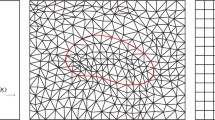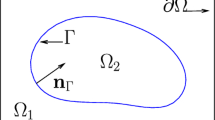Abstract
We define a new finite element method for a steady state elliptic problem with discontinuous diffusion coefficients where the meshes are not aligned with the interface. We prove optimal error estimates in the \(L^2\) norm and \(H^1\) weighted semi-norm independent of the contrast between the coefficients. Numerical experiments validating our theoretical findings are provided.



Similar content being viewed by others
References
Adjerid, S., Ben-Romdhane, M., Lin, T.: Higher degree immersed finite element methods for second-order elliptic interface problems. Int. J. Numer. Anal. Model. 11(3), 541–566 (2014)
Barrau, N., Becker, R., Dubach, E., Luce, R.: A robust variant of NXFEM for the interface problem. C. R. Math. Acad. Sci. Paris 350(15–16), 789–792 (2012)
Becker, R., Burman, E., Hansbo, P.: A Nitsche extended finite element method for incompressible elasticity with discontinuous modulus of elasticity. Comput. Methods Appl. Mech. Eng. 198(41–44), 3352–3360 (2009)
Brenner, S.C., Scott, L.R.: The Mathematicaltheory of Finite Element Methods, Volume 15 of Texts in Applied Mathematics. Springer, New York (1994)
Burman, E.: Ghost penalty. C. R. Math. Acad. Sci. Paris 348(21–22), 1217–1220 (2010)
Burman, E., Hansbo, P.: Fictitious domain methods using cut elements: III. A stabilized Nitsche method for Stokes’ problem. ESAIM Math. Model. Numer. Anal. 48(3), 859–874 (2014)
Burman, E., Zunino, P.: Numerical approximation of large contrast problems with the unfitted Nitsche method. In: Frontiers in Numerical Analysis—Durham 2010, Volume 85 of Lecture Notes in Computational Science and Engineering, pp. 227–282. Springer, Heidelberg (2012)
Chu, C.-C., Graham, I.G., Hou, T.-Y.: A new multiscale finite element method for high-contrast elliptic interface problems. Math. Comput. 79(272), 1915–1955 (2010)
do Carmo, M.P.: Differential Geometry of Curves and Surfaces. Prentice-Hall Inc, Englewood Cliffs (1976). Translated from the Portuguese
Dryja, M., Widlund, O.B.: Domain decomposition algorithms with small overlap. SIAM J. Sci. Comput. 15(3), 604–620 (1994). (Copper Mountain Resort, CO, 1992)
Gilbarg, D., Trudinger, N.S.: Elliptic Partial Differential Equations of Second Order, Volume 224 of Grundlehren der Mathematischen Wissenschaften [Fundamental Principles of Mathematical Sciences], 2nd edn. Springer, Berlin (1983)
Gong, Y., Li, B., Li, Z.: Immersed-interface finite-element methods for elliptic interface problems with nonhomogeneous jump conditions. SIAM J. Numer. Anal. 46(1), 472–495 (2008)
Gong, Y., Li, Z.: Immersed interface finite element methods for elasticity interface problems with non-homogeneous jump conditions. Numer. Math. Theory Methods Appl. 3(1), 23–39 (2010)
Grisvard, P.: Elliptic Problems in Nonsmooth Domains, Volume 24 of Monographs and Studies in Mathematics. Pitman (Advanced Publishing Program), Boston (1985)
Hansbo, A., Hansbo, P.: An unfitted finite element method, based on Nitsche’s method, for elliptic interface problems. Comput. Methods Appl. Mech. Eng. 191(47–48), 5537–5552 (2002)
Hansbo, P.: Nitsche’s method for interface problems in computational mechanics. GAMM-Mitt. 28(2), 183–206 (2005)
He, X., Lin, T., Lin, Y.: Immersed finite element methods for elliptic interface problems with non-homogeneous jump conditions. Int. J. Numer. Anal. Model. 8(2), 284–301 (2011)
He, X., Lin, T., Lin, Y.: The convergence of the bilinear and linear immersed finite element solutions to interface problems. Numer. Methods Partial Differ. Equ. 28(1), 312–330 (2012)
Huang, J., Zou, J.: Some new a priori estimates for second-order elliptic and parabolic interface problems. J. Differ. Equ. 184(2), 570–586 (2002)
Li, Z., Lin, T., Xiaohui, W.: New Cartesian grid methods for interface problems using the finite element formulation. Numer. Math. 96(1), 61–98 (2003)
Lin, T., Lin, Y., Zhang, X.: Partially penalized immersed finite element methods for elliptic interface problems. SIAM J. Numer. Anal. 53(2), 1121–1144 (2015)
Massing, A., Larson, M.G., Logg, A., Rognes, M.E.: A stabilized Nitsche fictitious domain method for the Stokes problem. J. Sci. Comput. 61(3), 604–628 (2014)
Massing, A., Larson, M.G., Logg, A., Rognes, M.E.: A stabilized Nitsche overlapping mesh method for the Stokes problem. Numer. Math. 128(1), 73–101 (2014)
Zunino, P.: Analysis of backward Euler/extended finite element discretization of parabolic problems with moving interfaces. Comput. Methods Appl. Mech. Eng. 258, 152–165 (2013)
Zunino, P., Cattaneo, L., Colciago, C.M.: An unfitted interface penalty method for the numerical approximation of contrast problems. Appl. Numer. Math. 61(10), 1059–1076 (2011)
Author information
Authors and Affiliations
Corresponding author
Additional information
J. Guzmán: supported by NSF- DMS 1318108. M. Sarkis: supported in part by NSF-MRI 1337943 and NSF-MPS 1522663.
Appendices
Appendix 1: Technical Lemmas
In this section we prove two technical lemmas involving geometrical estimates on elements intersected by the interface \(\Gamma \). We remind the reader that we assume that \(\Gamma \) is a simple \({\mathcal {C}}^2\) curve with an arc-length parameterization \(\varvec{X}:[0,|\Gamma |)\rightarrow \Gamma \), and assumption (1)–(3) in Sect. 2.1.
We assume that r is the radius of our tubular neighborhood given in Lemma 1. Equivalently, for any \(0< {\tau }\le r\) we have
Moreover, for any \(x \in Tub(r)\) there exists a unique \(x_\Gamma \in \Gamma \) such that \(\text {dist}(x,x_\Gamma )=\text {dist}(x, \Gamma )\) and \(x-x_\Gamma \) is perpendicular to \(\Gamma \) at \(x_\Gamma \).
Lemma 13
Consider the \(\Gamma _{s}\) a segment of the curve \(\Gamma \) and \(\ell \) the straight segment connecting the two end points of \(\Gamma _{s}\). Assume that \(|\ell | \le r\), where r is the radius of the r-tubular neighborhood. Then, it holds
Proof
Let \(x_1, x_2\) be the endpoints of the line segment \(\ell \). For \(i=1,2\), let \(N_{i}\) be the line that is normal to \(\Gamma \) at \(x_i\). Let \({\tilde{S}}\) be the infinite region enclosed by \(N_{1}\) and \(N_{2}\), then let \(S= Tub(r/2) \cap {\tilde{S}}\) be the tubular section of \(\Gamma _s\). We see that the area of S is given by \(|S|= r|\Gamma _{s}|\). Let \(M_{i}\) \(i=1,2\) be the two lines that are parallel to \(\ell \) and distance r from \(\ell \). Consider the trapezoid, R, enclosed by \(N_{i}, M_{i}, i=1,2\). We note that the area of R is given by \(|R|=2 r |\ell |\). The result will follow if we show that \(S \subset R\) since this will imply that \(r|\Gamma _{s}| \le 2r|\ell |\).
To this end, we first note that the line segment \(\ell \subset Tub(r/2)\) since the distance of any point in \(\ell \) to \(\Gamma \) is less than \(|\ell /2|\) which we are assuming is less than r / 2. Let \(x \in S\), then we know there exists a unique point \(x_\Gamma \in \Gamma _s\) where the distance from x to \(x_\Gamma \) is less than r / 2 and the line, which we denote by \(L_x\), that passes through x and \(x_\Gamma \) is perpendicular to \(\Gamma \) at \(x_\Gamma \). We know that \(L_x\) intersects \(\ell \) and we call this point y. We also know that distance between y and \(x_\Gamma \) is less than r / 2 since \(y \in \ell \subset Tub(r/2)\). Hence, we have shown that \(\text {dist}(y,x) \le r\). This, of course implies that the distance of x to the infinite line \(\ell _{\text {ext}}\) (which is the line that contains the line segment \(\ell \)) is at most r. In other words, x is in between the two lines \(M_1\) and \(M_2\). Since x was in the tubular section S it was in between the two lines \(N_1\) and \(N_2\) and hence x belongs to the trapezoid R. (Fig. 4) \(\square \)
1.1 Proof of Lemma 6
Let \(e=\mathrm {Int}(\partial T_1\cap \partial T_2)\in {\mathcal {E}}_h^\Gamma \), with \(T_1, T_2\in {\mathcal {T}}^h\), and the previous definitions of \(e^\pm = e\cap \Omega ^\pm \). We analyze the case in \(\Omega ^-\). The same analysis is valid in \(\Omega ^+\). We proceed analyzing two cases depending on the intersection of the edge e with \(\Gamma \):
-
(i)
If \( e\cap \Gamma = \emptyset \), (\(e=e^-\)). If either \(T_1\) or \(T_2\) does not belong to \({\mathcal {T}}_h^\Gamma \) the results is trivial. Consider the case where \(T_1\) and \(T_2\) belong to \({\mathcal {T}}_h^\Gamma \), the interface sections \(T_{1,\Gamma }\) and \(T_{2,\Gamma }\) are nonempty. We consider the midpoint \(m_e\) the segment e and the ball \(B_{|e|/2}(m_e)\) of radius |e| / 2 and centered at \(m_e\). If the interface does not cross the ball \(B_{|e|/ 2}(m_e)\) then we have
$$\begin{aligned} |T_1^{-}|\ge |B_{|e|/ 2}(m_e) \cap T_1|. \end{aligned}$$Denote by \({\underline{\alpha }}\) the minimum angle of the triangulation (given by shape regularity), and let \({\tilde{\alpha }}=\min \{{\underline{\alpha }}, \pi /4\}\). Now consider the isosceles triangle \({\tilde{T}}_1\) with base edge e and base angles \({\tilde{\alpha }}\). Then, clearly \({\tilde{T}}_1 \subset B_{|e|/ 2}(m_e) \cap T_1\) and \(|{\tilde{T}}_1 |=(|e^-|/2)^2\tan \{{\tilde{\alpha }}\}\). Therefore, \(|T_1^{-}| \ge (|e^-|/2)^2\tan \{{\tilde{\alpha }}\}\). Assume then that the interface crosses the ball \(B_{|e|/2}(m_e)\) in \(T_1\). Observe that this implies that there exists a point in \(T_{1,\Gamma }\) who’s normal passes through \(m_e\) with distance less than |e| / 2. Now, if \(T_{2,\Gamma }\) crosses the ball then we will have two points on \(\Gamma \) at a distance less than |e| / 2 whose normal passes through \(m_e\) which contradicts the tubular neighborhood assumption. Therefore
$$\begin{aligned} \max _{i=\{1,2\}}|T_{i}^{-}|\ge \Big (\frac{|e|}{2}\Big )^2\tan \{{\tilde{\alpha }}\}. \end{aligned}$$ -
(ii)
If \(e\cap \Gamma \ne \emptyset \). Similarly as in the previous case, consider \(m_e\) the midpoint of \(e^{-}\) and the ball of radius \(|e^{-}|/2\) centered at \(m_e\). We observe that this ball can not cross both \(T_{1,\Gamma }\) and \(T_{2,\Gamma }\). Therefore
$$\begin{aligned} \max _{i=\{1,2\}}|T_{i}^{-}|\ge \Big (\frac{|e^-|}{2}\Big )^2\tan \{{\tilde{\alpha }}\}. \end{aligned}$$
1.2 Proof of Lemma 11
We analyze the case in \(\Omega ^-\). We first observe that, by triangle inequality we have
Therefore, using Lemma 13
Same analysis is valid to prove the statement in \(\Omega ^+\).
Appendix 2: Construction of Basis Functions of \(S^{1}(T)\)
In this section we define basis functions \(\{w_1,w_2,w_3\}\) of the space \(S^{1}(T)\), for \(T\in {\mathcal {T}}_h^{\Gamma }\). Consider \(\{x_1,x_2,x_3\}\) nodes of the element T. Let \(\{\lambda _1,\lambda _2,\lambda _3\}\) be the barycentric coordinates of a point \(x\in T\) with respect to \(\{x_1,x_2,x_3\}\). Consider the following representation
We construct \(\{w_1,w_2,w_3\}\), a set of basis functions of the space \(S^1(T)\), by satisfying the following conditions: for \(i =1,2,3\)
These conditions are written in a system of size \(6\times 6\) using the barycentric coordinates representation of \(w_i^{\pm }\), i.e., we find the unknowns coefficients \(\{a_{i,j}^{\pm }\}_{j=1}^{3}\) of \(w_i\) for \(i=1,2,3\), solutions of:
where
Rights and permissions
About this article
Cite this article
Guzmán, J., Sánchez, M.A. & Sarkis, M. A Finite Element Method for High-Contrast Interface Problems with Error Estimates Independent of Contrast. J Sci Comput 73, 330–365 (2017). https://doi.org/10.1007/s10915-017-0415-x
Received:
Revised:
Accepted:
Published:
Issue Date:
DOI: https://doi.org/10.1007/s10915-017-0415-x





